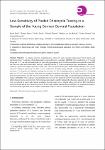Low Sensitivity of Pooled Chlamydia Testing in a Sample of the Young German General Population
Haar, Karin
Meyer, Thomas
Desai, Sarika
Thamm, Michael
Heiden, Matthias an der
Bremer, Viviane
Hamouda, Osamah
Objective: To compare sensitivity of pooled urine testing with single specimen testing using NAAT (nucleic acid amplification test). To determine Chlamydia prevalence among adolescents in Germany. Methods: Urine samples from 15-17 year old female and 16-17 year old male participants of a nationwide representative study in children and adolescents sampled between 2003 and 2006 were tested individually and in pools of 4 using BDProbeTec ET System (strand displacement amplification). Specificity, sensitivity, positive and negative predictive values (PPV, NPV) for pooled testing with 95%-confidence-intervals (95% CI) was calculated. Chlamydia prevalence with 95% CI was calculated for individual testing. Results: Among individually tested 1925 specimens, 27 were positive for chlamydia, resulting in a prevalence of 1.4%. Chlamydia prevalence ranged from 0.2% in 16-year old males to 3.2% in 17-year old females. Using individual testing as the standard, a specificity of 99.6% and a sensitivity of 56.0% was found for pooled testing. The PPV was 87.5% and the NPV 97.6%. Inhibition was higher in individual testing compared to pooled testing. Conclusion: In this setting of a national health survey the very low sensitivity of 56.0% for pooled testing is concerning and differs from previously reported results. Pooled chlamydia test results should be interpreted with caution, especially if urine samples were not collected or stored under optimal conditions. Possible causes such as dilution effects, lack of prior DNA purification, long-term-storage and the use of urines that may not be first-void should be ruled out. Recommendations for population screening to use pooled testing might need to be re-evaluated should larger studies on more recent samples confirm our findings.
No license information

